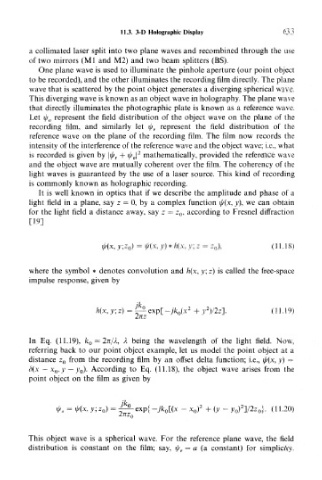Page 649 - Introduction to Information Optics
P. 649
11.3. 3-D Holographic Display 633
a collimated laser split into two plane waves and recombined through the use
of two mirrors (M1 and M2) and two beam splitters (BS).
One plane wave is used to illuminate the pinhole aperture (our point object
to be recorded), and the other illuminates the recording film directly. The plane
wave that is scattered by the point object generates a diverging spherical wave,
This diverging wave is known as an object wave in holography. The plane wave
that directly illuminates the photographic plate is known as a reference wave.
Let \l/ 0 represent the field distribution of the object wave on the plane of the
recording film, and similarly let \l/ r represent the field distribution of the
reference wave on the plane of the recording film. The film now records the
intensity of the interference of the reference wave and the object wave; i.e., what
2
is recorded is given by \(j/ r + i^J mathematically, provided the reference wave
and the object wave are mutually coherent over the film. The coherency of the
light waves is guaranteed by the use of a laser source. This kind of recording
is commonly known as holographic recording.
It is well known in optics that if we describe the amplitude and phase of a
light field in a plane, say z = 0, by a complex function ij/(x, y), we can obtain
for the light field a distance away, say z = z 0, according to Fresnel diffraction
[19]
4/(x, y; z 0) = ij/(x, y) * h(x, y; z = z ()), (11.18)
where the symbol * denotes convolution and h(x, y\z) is called the free-space
impulse response, given by
2
2
h(x, j>; z) = -~ exp[~jk Q (x + y ]/2z]. (11.19)
In Eq. (11.19), k 0 = 2n/A, A being the wavelength of the light field. Now,
referring back to our point object example, let us model the point object at a
distance z 0 from the recording film by an offset delta function; i.e., \J/(x, y) =
6(x — x 0,y — y 0). According to Eq. (11.18), the object wave arises from the
point object on the film as given by
2
2
, y; z 0) = - exp{ -jk 0[_(x - x 0) + (y - y 0) ]/2z 0), (11.20)
This object wave is a spherical wave. For the reference plane wave, the field
distribution is constant on the film; say, \l/ r - a (a constant) for simplicity.

